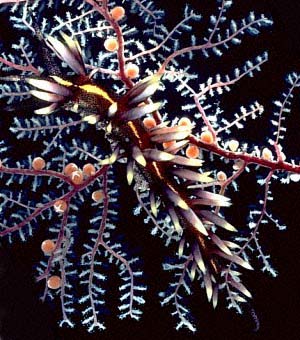

Protaeolidiella atra
Baba, 1955
Order: NUDIBRANCHIA
Suborder: AEOLIDINA
Family: Aeolidiidae
DISTRIBUTION
Tropical Indo-West Pacific
PHOTO
UPPER: On its food, the athecate hydroid, Solanderia fusca, 27mm long.
MIDDLE: Solanderia colony stripped of all polyps, with three Protaeolidiella egg masses.
LOWER: showing how well camouflaged Protaeolidiella is on Solanderia, 20mm long. Heron Is, Great Barrier Reef, Queensland, June 1983.
PHOTOS: Bill Rudman.
Protaeolidia atra is a rather unusually shaped member of the Aeolidiidae, perhaps with reduced cerata and relatively narrow shape so that it is better camouflaged on the hydroid colonies on which it lives. Its internal anatomy is quite interesting as it has developed ducts of the digestive gland in the body wall as well as the cerata. This is unique in aeolids without zooxanthellae symbiosis and I have suggested that this is to replace the digestive gland volume lost when the number of cerata were reduced.
See message below for a discussion on whether P. atra and P. juliae are distinct species, the latter having a white line down the dorsal midline.
References:
• Baba, K. (1955) Opisthobranchia of Sagami Bay. Supplement. Iwanami Shoten, Tokyo.
• Baba, K. (1992) Comment on the taxonomy of Protaeolidiella atra Baba, 1955 and an allied species from Japan. Report of the Sado marine Biological Station, Niigata University, 22: 29-35.
• Rudman, W.B. (1990.) Protaeolidiella atra Baba, 1955 and Pleurolidia juliae Burn, 1966; one species, two families (Nudibranchia). Journal of Molluscan Studies, 56(4): 505-514.
Rudman, W.B., 1999 (April 1) Protaeolidiella atra Baba, 1955. [In] Sea Slug Forum. Australian Museum, Sydney. Available from http://www.seaslugforum.net/find/protatra
Related messages
Protaeolidiella sp. from Sth Korea
March 24, 2003
From: Dong Bum, Koh
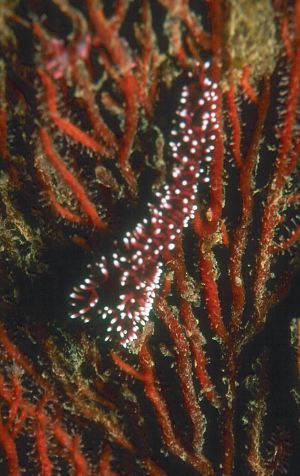
Dear Bill,
Here is another new photo of Protaeolidiella sp. for your Forum.
It is from Moon islet Dec. 2002. Depth: 5m
In total I hve now posted 4 messages in the Forum from Cheju island, Sth Korea.
I hope they will be useful in your Forum.
Best regards,
Dong Bum, Koh
drkoh@seasee.co.kr
Koh, D.B., 2003 (Mar 24) Protaeolidiella sp. from Sth Korea. [Message in] Sea Slug Forum. Australian Museum, Sydney. Available from http://www.seaslugforum.net/find/9218Thanks Dong Bum,
I am not sure how we are going to resolve if there is one or more species. Possibly the black and brown ones are different, but could this colour difference be a colour difference in the Solanderia colony? Firstly, I am not sure what the differences between P. atra and P. juliae are supposed to be?
Best wishes,
Bill Rudman
Another Protaeolidiella atra from Korea
October 30, 2002
From: Dong Bum, Koh
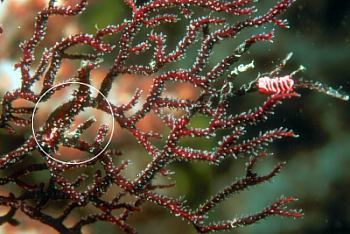
Dear Bill,
Recently I had an exciting diving in Moon Islet, and have added these new photos to my data. This Proteolidiella atra, is very tiny when compared with my prior brown animal and is well camouflaged on the hydroid colonies on which it lives.
Moon islet, Seogywpo. Che Ju Island, Sth Korea. 15m depth., 27 Oct.2002
Photos: Dong Bum, Koh
Best regards,
Dong Bum, Koh
drkoh@seasee.co.kr
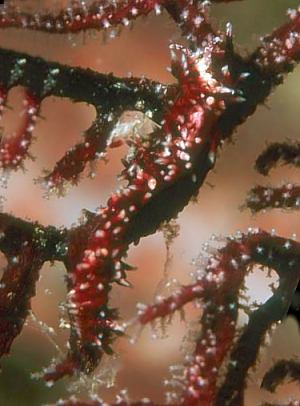
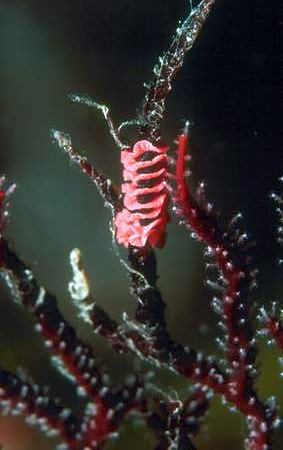
Thanks Dong Bum,
Bill Rudman
More questions about Protaeolidiella atra
October 18, 2002
From: Dong Bum, Koh
Dear Dr Bill,
Thanks a lot for your comments and suggestion that the morphological differences may be environmental adaptations. Howevere the colour of the rhinophores of Protaeolidiella atra are different in my photos posted your Forum. Is it possible for the rhinophores to change colour in the same species through environmental factors?
Best wishes,
Dong Bum, Koh
drkoh@seasee.co.kr
Koh, D.B., 2002 (Oct 18) More questions about Protaeolidiella atra. [Message in] Sea Slug Forum. Australian Museum, Sydney. Available from http://www.seaslugforum.net/find/8166Dear Dong Bum,
It is of course possible that I am quite wrong and there are two or perhaps three species involved in this Protaeolidiella complex. In your black animals the rhinophores appear black except for a transparent basal region. In your brown animals the rhinophores are essentially transparent. My interpretation of that is that the brown animals are lacking the black pigment found in the black animals. In some parts of the body this gives them the brown appearance, and in other parts, such as the rhinophores, it makes them transparent. If they are all one species, I don't know whether the colour difference is genetic or whether it is environmental. It is possible that the black pigment is derived from their food?
All I can say is that there is plenty of research that needs to be done,
Best wishes,
Bill Rudman
Protaeolidiella sp. from Korea
October 11, 2002
From: Dong Bum,Koh
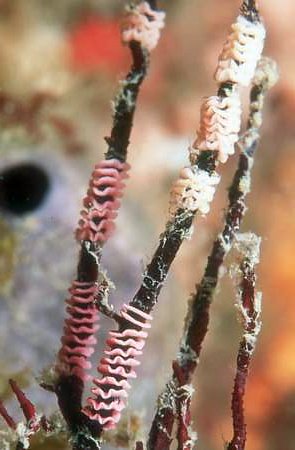
Dear Bill,
Here are photos of Protaeolidiella sp. & its egg bands. Could you give me more informations about this?
Date: 4 August.2002
Location: Moon islet in CheJu island, Korea
Depth: 20m
Best regards,
Dong Bum, Koh
drkoh@seasee.co.kr
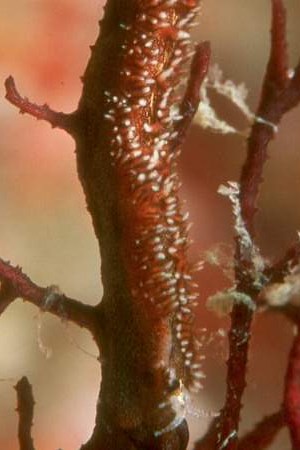
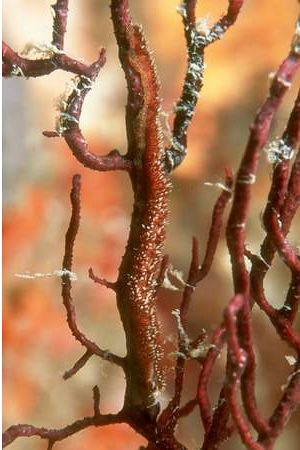
Dear Dong Bum,
Thanks for these photos and the ones in your other message. As I have discussed, in reponse to an earlier message, I can't find any good characters to separate Protaeolidiella atra and Protaeolidiella juliae. I can't find anatomical differences, and the only constant external difference is the presence or absence of a dorsal median white band. Also the egg ribbon is identical in all forms. 'Typically' both 'species' are black with white tipped cerata. In some cases the cerata seem very short and other times they appear much longer. Of interest though are the brown animals you have photographed here. They have very short cerata in comparison with the body length. However if we look at the brown animal in Yasuhiro Shirai's photo we see it has very long cerata in proportion to the body length.
So it seems both the black and brown forms can have short or long cerata. And certainly the black form can either have a white stripe or not. What may be happening is that the animals are matching the hydroid colony they are on. Your animals here are on a brown stalked colony with very sparse polyps. Its body shape and colour are very cryptic on this colony. If you compare this with black forms with long cerata they are often on hydroid colonies which are black, with many short branches forming a very tangled network. The black long-cerata form is certainly very cryptic on this type of colony.
I don't know if there is more than one species of the hydroid, or whether it is one species with different growth forms. Unfortunately I can't see any simple way of determining whether we have one or two species of Protaeolidiella present. Another possibly confusing factor is that the present two names apply to black animals. Anyone considering brown to be an important character, would need to seriously contemplate naming a third species - which would certainly not help to clarify the situation.
Best wishes,
Bill Rudman
Protaeolidiella sp. from Korea (2)
October 11, 2002
From: Dong Bum,Koh.

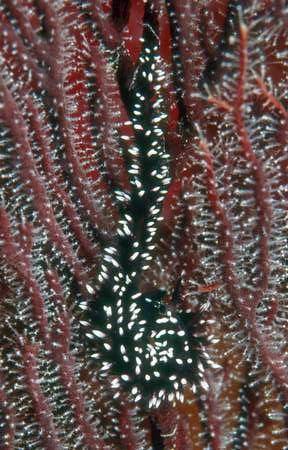
Dear Bill,
Here are photos of another Protaeolidiella sp.. Could you please compare them with my previous message. I look forward to hearing from you in your Forum.
21 April 2002
Moon islet in CheJu island, Korea. 5m depth
Taken by Dong Bum, Koh
Best wishes,
from Dong Bum,Koh.
drkoh@seasee.co.kr
Koh, D.B., 2002 (Oct 11) Protaeolidiella sp. from Korea (2). [Message in] Sea Slug Forum. Australian Museum, Sydney. Available from http://www.seaslugforum.net/find/7962Dear Dong Bum,
Thanks for these interesting photos. This looks very like the black form we find in Australia, but your animal does not seem to have the white stripe, normally found in Australian specimens. It does however look very like Baba's illustration of Protaeolidiella atra. I still suspect this form, and the one in your other message, are colour forms of the same species, but I am not sure how easy it will be to determine.
Best wishes,
Bill Rudman
Japanese Protaeolidiella atra (without a stripe)
September 23, 2001
From: Yasuhiro Shirai
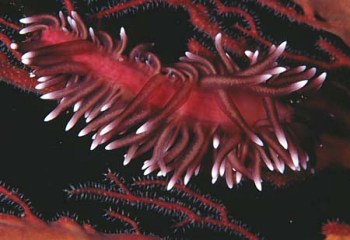
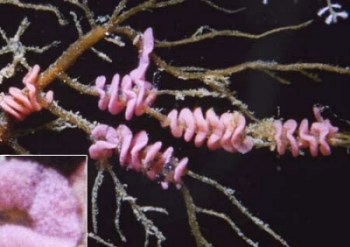
Dear Bill,
I saw Nishina's message about Protaeolidiella atra on your Forum. I have found Protaeolidiella with and without the white stripe at Kushimoto, Kii Peninsula, central Japan. They are on my website at http://www.sea-slug.com. Here are some of the photos of Protaeolidiella atra, without a white stripe, to add to the ones I sent in an earlier message
This individual is very large and it has very long cerata. I took photo at Mie, Shijima Prefecture, central Japan. P. atra is a common slug in this area, but they don't have white line on their back.
I have also included a photo of their egg ribbons. I have sent photos of the striped animal in a separate message.
Mie, Shijima Prefecture, central Japan, 2 July, 2000.
Length: about 70mm.
Depth: 18m.
Water temperature: 21 degree.
Best wishes,
Yasuhiro Shirai
yasuhiro@e-net.or.jp
Shirai, Y., 2001 (Sep 23) Japanese Protaeolidiella atra (without a stripe). [Message in] Sea Slug Forum. Australian Museum, Sydney. Available from http://www.seaslugforum.net/find/5302Thanks Yasuhiro,
The egg ribbons are particularly interesting because they look identical to those in my photo at the top of the page which were layed by a white striped animal from Australia. Similarly I don't think the length of the cerata is very important because the length of the cerata is quite variable, perhaps because they are easily autotomised, and so can be in a stage of regrowth.
Best wishes,
Bill Rudman
Japanese Protaeolidia juliae? (with a stripe)
September 23, 2001
From: Yasuhiro Shirai
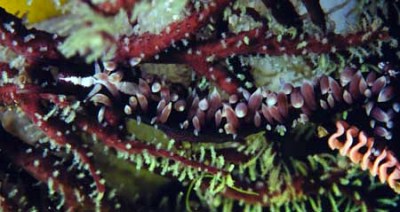
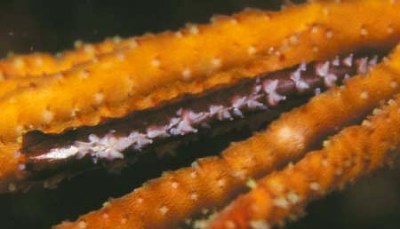
Dear Bill,
To accompany my other message here are two images of an animal that is called Protaeolidiella juliae in Japanese guide books. They have white line on their back. I took photo at Wakayama, Kushimoto Prefecture, central Japan.
UPPER: June 18, 2000.
Length about 50mm. (An adult).
Depth 16m.
Water temperature 22 degree.
LOWER: July 19, 2000.
Length about 15mm.
Depth 17m.
Water temperature 23 degree.
Best wishes,
Yasuhiro Shirai
yasuhiro@e-net.or.jp
Shirai, Y., 2001 (Sep 23) Japanese Protaeolidia juliae? (with a stripe). [Message in] Sea Slug Forum. Australian Museum, Sydney. Available from http://www.seaslugforum.net/find/5303Dear Yasuhiro,
Thanks again for sending these photos. The only consistent difference I can find between P. juliae and P. atra is that P. juliae is said to have a white stripe down the dorsal midline. As far as I can determine this white-striped form is the colour form found throughout the Indo-West Pacific. The P. atra colour form, without a stripe seems to be found only in Japan. If anyone has a photo of an animal without a white stripe from somewhere other than Japan, I would be very interested to know about it. Ironically P. juliae was described from a preserved animal so we do not know if it had a white stripe or not.
Best wishes,
Bill Rudman
Re: Protaeolidiella atra from Sagami Bay
September 19, 2001
From: Nishina Masayoshi
Dear Dr.Rudman,
Concerning your question - "Have you seen any animals with a white line down the centre of their back?"
I've never seen Protaeolidiella atra with with a white line down the center of their back here. I believe that P. atra in Japan has no white line. I found a photo of an animal [Ono, 1999] which looks like Protaeolidiella atra but it is called Protaeolidiella juliae Burn, 1966. P. juliae looks very much like P. atra but it has a white line down the centre of their back.
Best Regards,
Nishina Masayoshi
nishina@hpe15.wips.co.jp
Nishina, M., 2001 (Sep 19) Re: Protaeolidiella atra from Sagami Bay. [Message in] Sea Slug Forum. Australian Museum, Sydney. Available from http://www.seaslugforum.net/find/5055Dear Nishina,
The reason I asked is that some years ago I decided P. atra and P. juliae were the same species (Rudman, 1990), the only difference being the white line in P. atra. It seems that both colour forms occur in Japan so I thought it would be interesting if anyone could find whether the white-striped form and the non striped animals were found together on the same hydroids, or whether they live on different species of hydroids. I discussed this matter in an earlier message from Yasuhiro Shirai.
It is one of those cases, like some species of Dendrodoris, where animals look different but there doesn't seem to be any anatomical differences.
Best wishes,
Bill Rudman
Protaeolidiella atra from Sagami Bay, Japan
August 7, 2001
From: Nishina Masayoshi
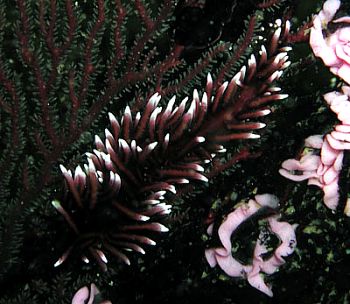
Dear Dr.Rudman,
Here is a photo of Protaeolidiella atra that Chikako took on 7th July, 2001 at Enoura beach, Sagami Bay, Japan.
Depth: 8m
Size: 50mm
Comment: Common here
Nishina Masayoshi
nishina@hpe15.wips.co.jp
Nishina, M., 2001 (Aug 7) Protaeolidiella atra from Sagami Bay, Japan. [Message in] Sea Slug Forum. Australian Museum, Sydney. Available from http://www.seaslugforum.net/find/4975Dear Nishina,
I am very interested in this species as I discuss in Mr Yasuhiro Shirai's message. Have you seen any animals with a white line down the centre of their back?
Best wishes,
Bill Rudman.
Protaeolidiella atra from Japan
November 4, 1999
From: Yasuhiro Shirai
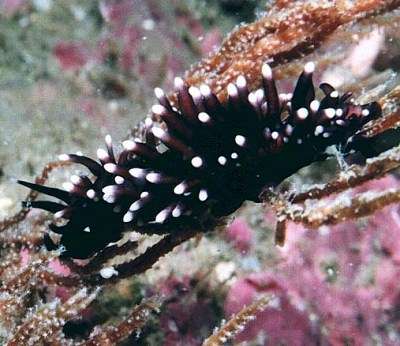
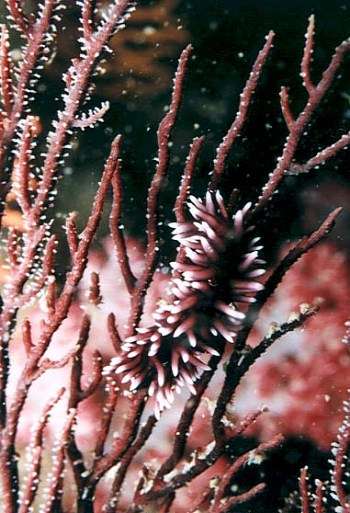
Dear Bill.
Thank you for your message. I am happy to put my photos on your Forum. I will send other sea slug photos.
I saw your website about Protaeolidiella atra. I have seen P. atra two times in this year, and they did not have a white line on their back.
I have attached their photos. If you are going to use them in your Forum,I am very happy.
I took the LOWER photo at Nansei, which is on the east side of Kii Peninsula, between Kusimoto and Nagoya. It was on the hydroid, depth 13m, water temperature 18C, about 50mm length, June 1999.
I took the UPPER photo at Shijima, which is about 20km east of Nansei. This one was also on the hydroid, depth 16m, water temperature 25C, about 50mm length, Aug 1999.
Best wishes.
Yasuhiro S.
yasuhiro@e-net.or.jp
Shirai, Y., 1999 (Nov 4) Protaeolidiella atra from Japan. [Message in] Sea Slug Forum. Australian Museum, Sydney. Available from http://www.seaslugforum.net/find/1485Dear Yasuhiro,
Thank you very much for sending the interesting photos of Protaeolidiella atra. When I looked at your website after your last message, I was very interested to see the photos of Protaeolidiella. When I reviewed these animals (Rudman, 1990) I considered the Japanese P. atra, without a white stripe, and the Australian P. juliae, with a white stripe to be the same species. The white-striped form is quite common throughout the indo-West Pacifc. Dr Baba (1992) still considers the Japanese animal, illustrated here, to be a distinct species. From Baba's illustrations, there do not seem to be any easily defined anatomical differences. If any one has seen both colour forms together, I would be very interested to hear of it. Dr Baba reports both striped and unstriped animals from Japan. One interesting difference is that the unstriped animals grow to over 50mm which is about twice as long as the largest striped specimen I have seen. Perhaps the striped animals are only found on Solanderia fusca.
The hydroid in Yasuhiro's photos is identified in Baba (1992) as Solanderia secunda (Inaba).
Best wishes,
Bill Rudman.
Yasuhiro's website is at http://www.e-net.or.jp/user/yasuhiro/ It is mostly in Japanese, but there is a section with nudibranch photos at:
http://www.e-net.or.jp/user/yasuhiro/diving/aquarium/umiusi/main.html
References:
•Baba, K. (1992) Comment on the taxonomy of Protaeolidiella atra Baba, 1955 and an allied species from Japan. Report of the Sado marine Biological Station, Niigata University, 22: 29-35.
•Rudman, W.B. (1990.) Protaeolidiella atra Baba, 1955 and Pleurolidia juliae Burn, 1966; one species, two families (Nudibranchia). Journal of Molluscan Studies, 56(4): 505-514.
Protaeolidiella atra from Indonesia
April 1, 1999
From: Lindsay Warren
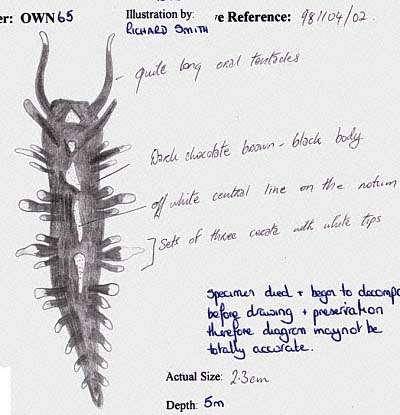
Dear Bill
Please find attached an illustrationby Richard Smith of an opisthobranch found in the Tukang Besi Islands, SE Sulawesi last year during the research for Operation Wallacea. Unfortunately it died and started to decompose before being able to photograph it. The specimen was, however, preserved.
Length: 2.3 cm. The long tapering body was a dark chocolate brown / black with off striking white central line on the notum. Along the sides were sets of three cerata with white tips. It had quite long oral tentacles also white tipped. It was found at a depth of 5 m on dead table coral rubble covered in algae.
Any thoughts as to what it might be?
All the best
Lindsay
100014.2112@compuserve.com
Warren, L., 1999 (Apr 1) Protaeolidiella atra from Indonesia. [Message in] Sea Slug Forum. Australian Museum, Sydney. Available from http://www.seaslugforum.net/find/745Dear Lindsay,
This looks like Protaeolidiella atra which I have found in East Africa and eastern Australia, and was originally described from Japan. Its black colouration is rather unusual in aeolids, and it has some rather interesting anatomical modifications.
Best wishes,
Bill Rudman.
